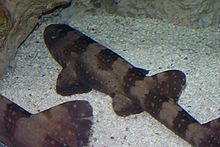Chiloscyllium
| Chiloscyllium | ||||||||||||
|---|---|---|---|---|---|---|---|---|---|---|---|---|

Banded Bamboo Shark ( Chiloscyllium punctatum ) |
||||||||||||
| Systematics | ||||||||||||
|
||||||||||||
| Scientific name | ||||||||||||
| Chiloscyllium | ||||||||||||
| Müller & Henle , 1837 |
Chiloscyllium is a genus within the real shark andthe bamboo shark family . It currently includes seven species that occur exclusively on the coasts of the Indo-Pacific.
features
All species of the genus are small and very slender, elongated species. Like the closely related epaulette sharks ( Hemiscyllium ), they reach a maximum body length of around 80 to 105 centimeters, but most species remain significantly smaller with an average of 50 to 60 centimeters. The largest species of the genus is the brown-banded bamboo shark with a maximum of 105 centimeters. The coloration can vary and is usually light brown, some species also show a conspicuous camouflage pattern of saddle spots, cross bars and spots, which in most species only occurs in young animals.
The mouth is clearly in front of the eyes, like all species of nurse shark they have 5 gill slits . The underside of the body is typically flattened for ground-dwelling shark species. The two dorsal fins are very far back, the first dorsal fin arises in all species behind or above the pelvic fins , the anal fin is always clearly behind the second dorsal fin.
distribution
The distribution area of the seven species is exclusively on the coasts of the Indo-Pacific. The main distribution area of the genus is in the coastal area from India along the Asian coast to Southeast Asia and in the area of the Indonesian islands . Individual species can occur around Madagascar , in the Persian Gulf and on the north coast of Australia .
All species live in shallow water near the coast, especially in coral reefs . Individual species are probably also found in brackish water in the area of river mouths and upper reaches. The depth distribution extends from the direct beach area to a maximum of about 100 meters.
Way of life
Very little information is available about the way of life of the species; much of the information comes from individual species in aquariums. They are sometimes nocturnal and hide in reef crevices during the day. Probably all species are oviparous and they feed on small fish and invertebrates. The white-spotted bamboo shark is one of the few species of shark in which asexual reproduction has been proven.
Systematics
The genus Chiloscyllium consists of seven species and, together with the epaulette sharks ( Hemiscyllium ), forms the family of bamboo or lip sharks (Hemiscylliidae) within the nurse shark-like (Orectolobiformes).
The seven types are:
- Arabian bamboo shark ( Chiloscyllium arabicum Gubanov in Gubanov & Shleib, 1980 )
- Burmese bamboo shark ( Chiloscyllium burmensis Dingerkus & DeFino, 1983 )
- Blue-spotted bamboo shark ( Chiloscyllium caerulopunctatum Pellegrin, 1914) - population of the white-spotted bamboo shark in the coastal area of Madagascar is often represented as a separate species
- Gray bamboo shark ( Chiloscyllium griseum Müller & Henle, 1838 )
- Indonesian bamboo shark ( Chiloscyllium hasselti Bleeker, 1852 )
- Slender bamboo shark ( Chiloscyllium indicum (Gmelin, 1789) )
- White-spotted bamboo shark ( Chiloscyllium plagiosum (Anonymous [Bennett], 1830) )
- Brown-banded bamboo shark ( Chiloscyllium punctatum Müller & Henle, 1838 )
Danger
All species of Chiloscyllium are included in the Red List of the International Union for Conservation of Nature (IUCN) due to high fishing pressure and a strong change in their habitats, in particular through the destruction of coral reefs as species on the warning lists ("near threatened"). An exception is the Burmese bamboo shark, for which there is insufficient data for a classification (“data deficient”).
supporting documents
- ↑ Kevin A. Feldheim, Demian D. Chapman, Doug Sweet, Seán Fitzpatrick, Paulo A. Prodöhl, Mahmood S. Shivji, Bob Snowden: Shark Virgin Birth Produces Multiple, Viable Offspring . In: Journal of Heredity . 101, No. 3, 2010, pp. 374-377. doi : 10.1093 / jhered / esp129 .
- ↑ according to Compagno et al. 2004.
literature
- Leonard Compagno , Marc Dando, Sarah Fowler: Sharks of the World. Princeton Field Guides, Princeton University Press , Princeton and Oxford 2005. ISBN 978-0-691-12072-0 , pp. 165-168
Web links
- Chiloscyllium on Fishbase.org (English)

